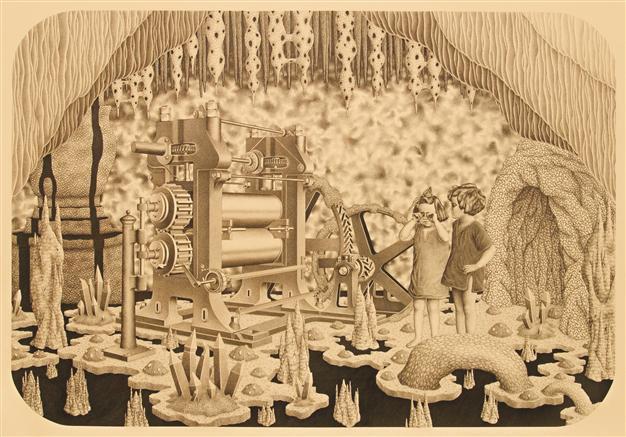Artist scratches beneath the surface with seed and bullet
ISTANBUL - Hürriyet Daily News

The works of Seymen have many symbols and codes and invite audiences to discover more. Seymen’sxhibition, is the product of three years of work, primarily with drawing, and it marks the first presentation of lmulti-layered project, ‘Sangoi.’
It might seem easy to understand the drawings and works of Erinç Seymen, but first impressions can be deceiving. Seymen’s works are meticulously created and need to be analyzed very closely in order to understand the surreal or unconscious ground that they stand on.
The works of Seymen have many symbols and codes and invite audiences to discover more. Seymen’s latest exhibition, “The Seed and The Bullet,” is the product of three years of work, primarily with drawing, and it marks the first presentation of the artist’s long-term, multi-layered project, “Sangoi” (2011–12).
“The Seed and The Bullet” calls into question the naturalization processes of social (dis)advantages, the preservation of social compromises, and/or the transformation of social differentiation-conflicts. Also significant is the way in which “The Seed and The Bullet” reveals the patient, intense attitude of production that has recently become more prominent in Seymen’s work. These recent works propose a new means of communication, directed toward reorganizing today’s relationship and perception conditions through a series of symbolic images that are related to and consistent with each other.

Erinç Seymen
The first sectionIn the first section of the exhibition, there are eight independent works. For “Surprise Witness 1” (2011) and “Surprise Witness 2” (2012), the artist has been inspired by various examples of utopian literature. He demands viewers contemplate the organization of labor in a classless society: Who gets to do the dirty work, and how will relationships of production be structured? These questions are constructed as ominous, fairy-tale-like moments of encounter. “Serva ex Machina” (2010) tests the boundaries of visual violence through the viewer’s level of perception, employing the motif of submission/colonialism in an intricate composition – a continuation of Seymen’s works that oscillate between evoking desensitization and alienation. With “Untitled” (2011), Seymen cynically deals with the controversy and asymmetry stemming from discrepancies in intentions. “Patriot” (2009) and “Loyalty” (2011), meanwhile, trace the permanent impact of devotedness, shared values and the culture of belonging. The supervisory/authoritarian eyes of institutions that never close follow the viewer in the exhibition space through “Daddy” (2011) and “Untitled” (2009).
The second section of the exhibition shows “Sangoi,” a multi-media work constituted by drawings, video and installation. “Sangoi” problematizes the uneven distribution of the roles of winners and losers, which are ruthlessly evident in today’s competitive society. The name of the project is derived from the imaginary country to which three young patients of Hans Zulliger, a Swiss psychoanalyst, escaped to realize various fantasies away from the adult world. Four important elements that determine negotiation abilities and social statuses through individual power mechanisms – class identity, cultural identity, desire and political power tools – trigger four series of 52 iconographic drawings that are transformed into a game that is never concluded.
The viewer is invited to enter a cloud of political memory through the wide grouping of symbols that are transformed into game cards that are then utilized in a video. Through this unique perspective, the connection between the rules of the game and the rules of society are called into question. The exhibition can be seen until Dec. 22.

